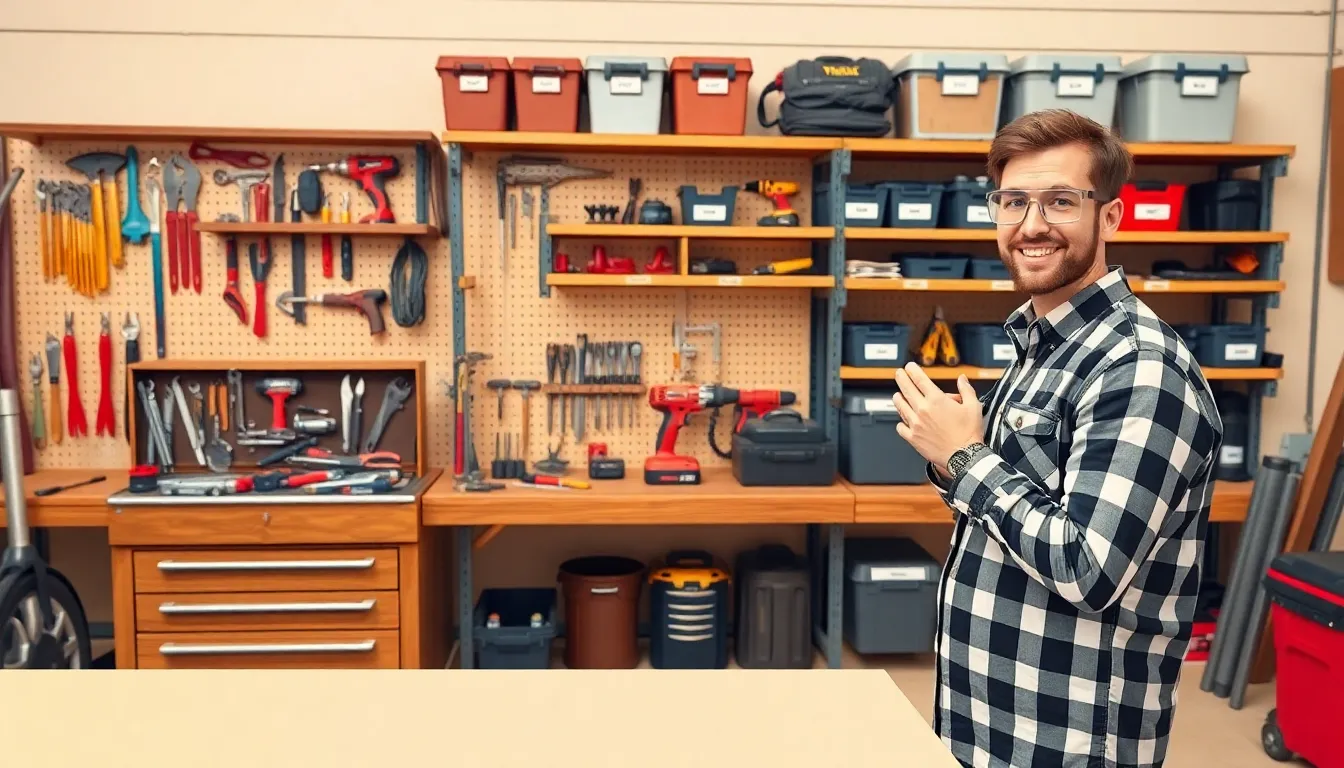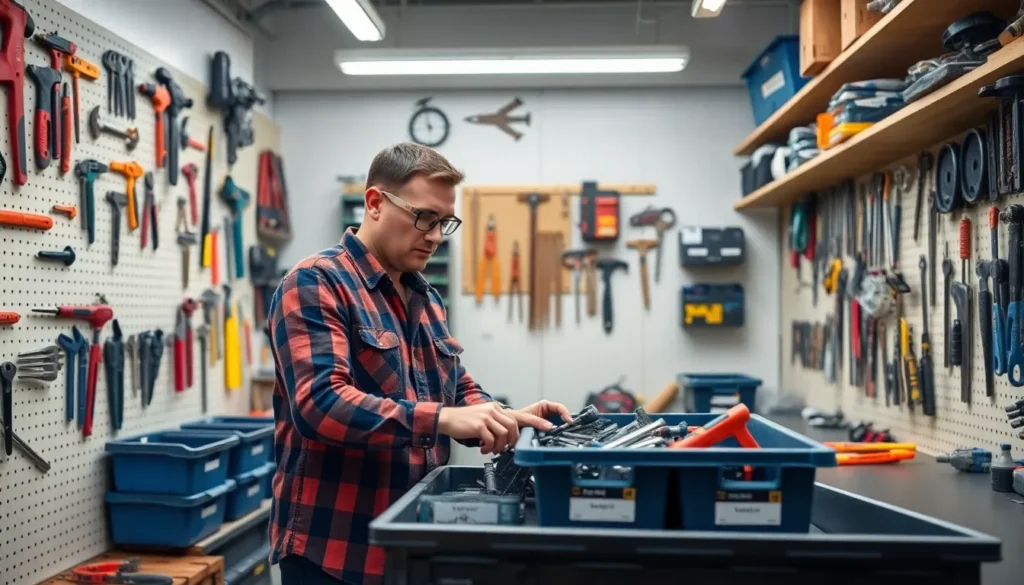Table of Contents
ToggleA cluttered workshop can feel like a chaotic circus where tools perform acrobatics, jumping from one surface to another. If you’ve ever spent more time searching for that elusive wrench than actually using it, you know the struggle is real. Organizing tools isn’t just about tidiness; it’s about reclaiming your sanity and boosting your productivity.
Planning Your Workshop Layout
Organizing a workshop layout involves careful planning that optimizes space and promotes efficiency. Proper organization contributes to streamlined processes and improved productivity.
Evaluating Available Space
Assessing the workshop’s dimensions and features is critical. Measure the width and length of the area to understand its capacity. Identify fixed structures such as windows, doors, and electrical outlets. Prioritize tool storage near workstations, ensuring easy access during projects.
Consider vertical storage options to maximize limited floor space. Utilize shelving units and pegboards for efficient organization. Arranging tools within arm’s reach speeds up task completion.
Designing an Efficient Workflow
Establishing a logical workflow enhances productivity. Group similar tools and materials together to reduce travel time between tasks. Organize the workspace into distinct zones for projects, assembly, and storage. Designate specific areas for commonly used tools to ensure quick access.
Create pathways to facilitate movement around the workshop without interruptions. Position larger tools or equipment at the rear or sides, maintaining clear access to smaller tools at the front. The result is a cohesive, easy-to-navigate workspace that supports efficient project execution.
Choosing the Right Storage Solutions

Selecting suitable storage solutions enhances tool organization and accessibility in a workshop. Each option serves different needs, with choices impacting efficiency and workflow.
Toolboxes and Tool Chests
Toolboxes and tool chests provide robust storage for various hand tools and equipment. Portable toolboxes allow mobility for small projects, while larger tool chests offer spacious drawers for organized storage. Many professionals prefer tool chests with lockable options to ensure security. In addition, choosing toolboxes with removable trays can simplify access to specific tools during tasks. Selecting a toolbox with a water-resistant design protects tools from moisture. Organizing tools by size and type within these storage options promotes efficiency.
Shelving and Racks
Shelving units and racks maximize vertical storage, offering easily accessible space for larger items. Installing heavy-duty shelves allows users to store bulk materials and tools without cluttering work surfaces. Adjustable shelving often accommodates tools of various sizes, making it versatile. Racks for power tools and maintenance supplies keep frequently used items within reach, reducing time spent searching. Opting for open shelving encourages visibility and quick identification of tools. Using labeled bins on shelves aids in maintaining organization and simplifies retrieval processes.
Categorizing Your Tools
Effective tool organization starts with categorization. By grouping tools according to their type and function, employees maintain a streamlined workflow and enhance productivity.
Hand Tools
Hand tools consist of items like hammers, screwdrivers, and wrenches. These tools should get organized based on their specific tasks and sizes. Allocate drawer space or use labeled bins for easy sorting, ensuring similar items stay together. Magnetic strips can hold frequently used tools within arm’s reach. This setup minimizes search time and promotes efficiency.
Power Tools
Power tools include drills, saws, and sanders. Storing these tools necessitates special attention due to their size and weight. Assign designated locations on shelving units or in tool chests close to a workstation. Use padded storage cases for protection and easily accessible charging stations for cordless tools. Label each storage space for quick identification, streamlining the process when switching between tasks or projects.
Specialty Tools
Specialty tools encompass items like routers or laser levels that serve specific purposes. Group these tools in dedicated storage bins or drawers, differentiated by their applications. Ensure they remain labeled for immediate recognition. Consider using wall-mounted storage for high-use specialty tools, making them visible and easy to reach. Organizing specialty tools judiciously alleviates clutter and enhances the likelihood of accomplishing projects effectively.
Labeling and Accessibility
Organizing tools in a workshop requires a clear approach to labeling and ensuring easy access. Effective labeling not only enhances tool visibility but also increases efficiency in the workspace.
Effective Labeling Systems
Labeling systems should use clear, legible fonts for easy identification. Color coding can also assist in categorizing tools by type or function, making the retrieval process straightforward. Using durable labels that withstand wear and tear prevents fading and ensures longevity. Labels must be placed in consistent locations on storage bins and shelves, enhancing familiarity with the setup. Additionally, creating a master list of labeled tools aids in quick identification and replacement.
Arranging for Easy Access
Arranging tools for easy access focuses on thoughtful placement within the workshop. Frequently used items should reside near workstations for minimal disruption to workflow. Setting up a designated space for each tool prevents overlap and promotes efficiency. Storing tools vertically, such as on pegboards or wall-mounted racks, maximizes space while keeping items within reach. Utilizing drawer dividers for smaller items keeps everything organized and accessible, ensuring a smooth work process throughout the day.
Maintaining Organization
To keep an organized workshop, regular maintenance and checks are essential. This proactive approach ensures tools stay in their designated spaces.
Regular Inventory Checks
Conducting regular inventory checks promotes accountability and organization. Checking tools every month helps identify misplaced items and unused equipment. Keeping a list of tools not only tracks what’s available but also helps prevent over-purchasing. Assessing condition during inventory ensures tools remain functional. Knowing which tools require replacement or repair also contributes to overall efficiency. Grouping commonly used tools can further streamline access during projects.
Cleaning and Upkeep
Routine cleaning directly impacts workshop organization. Setting aside time weekly to clean surfaces fosters a more inviting work environment. Dust and debris can accumulate quickly, affecting both tools and workspace productivity. Utilizing appropriate cleaning supplies ensures tools remain in optimal condition and reduce the risk of damage. Designating a specific area for disposing of waste materials contributes to a cleaner space. A tidy workshop layout encourages focus and enhances project execution, allowing for a smoother workflow.
An organized workshop is key to maximizing productivity and efficiency. By implementing thoughtful storage solutions and categorizing tools effectively, individuals can create a streamlined workspace that fosters creativity and focus. Regular maintenance and inventory checks ensure that the organization remains intact over time, preventing clutter from creeping back in.
With a little planning and commitment to keeping the space tidy, anyone can transform their workshop into a well-ordered haven for creativity and productivity. Embracing these strategies not only enhances the overall work experience but also makes every project more enjoyable and efficient.




